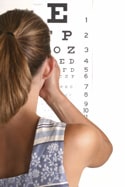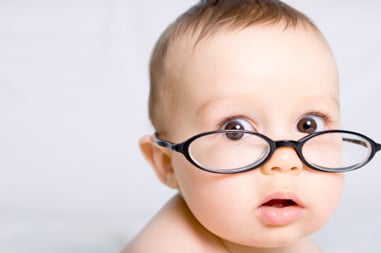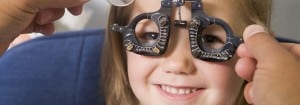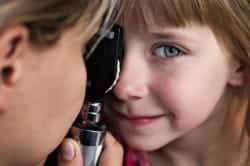
Kids’ Eye Exams
Most parents are used to taking their children to the pediatrician and the dentist for regularly scheduled checkups. However, many parents don’t realize that their children should also have regular eye exams – even if the child doesn’t wear glasses.
Do You Take Your Kid to the Eye Doctor for a Regular Checkup?
Most parents are used to taking their children to the pediatrician and the dentist for regularly scheduled checkups. However, many parents don’t realize that their children should also have regular eye exams – even if the child doesn’t wear glasses. Why?
Eye problems are very common in children. The American Optometry Association (AOA) estimates that 1 in 4 children has a vision-related condition. Left untreated, these conditions can have a serious effect on a child’s learning, development, athletic performance, and overall health.

The Advantages of Regularly Scheduled Vision Screening by Your Optometrist
Appropriate vision testing at an early age is vital to insure your child has the visual skills he or she needs to perform well in school. A child who is unable to see print or view a blackboard can become easily frustrated, leading to poor academic performance. Some vision problems, such as lazy eye, are best treated if they are detected and corrected as early as possible while the child’s vision system is still developing.
- Poor vision directly affects learning. When a child has difficulty focusing or cannot see things clearly, his learning and attention can suffer. In fact, the American Optometric Association has estimated that 60% of learning disabilities are associated with vision problems: when a child is suspected of having ADD/ADHD or another learning disorder, a comprehensive eye examination probably makes sense as well.
- Eye problems can affect development. Poor vision can affect not only learning and behavior but also can affect a child’s physical and neurological development. Eye muscle imbalances (called strabismus, or commonly “crossed eyes” or “wandering eyes”), for example, can lead to amblyopia (“lazy eye”) in which the brain suppresses vision from one eye to avoid seeing double. This can lead to permanent vision loss if untreated.
- Eye problems can also affect physical abilities and athletic performance. Vision irregularities or eye muscle imbalances can affect depth perception, leading to “clumsiness,” tripping, and poor hand-eye coordination.
- While very rare, children sometime experience more serious eye conditions such as cancerous tumors (retinoblastoma, medulloepithelioma), congenital glaucoma, retinal disease, etc. that can cause blindness and even be life-threatening.
That’s why it’s so important to have your kids’ eyes screened regularly by an optometrist.
When Should You Schedule Your Baby’s First Eye Exam?
Parents might not even think about whether your baby has a vision problem unless there are signs of a vision problem. But we recommend eye exams for infants because early identification of a child’s vision problem is key; children often are more responsive to treatment when problems are diagnosed early. So, we recommend that infants should have their first comprehensive eye exam at 6 months of age. Children then should have additional eye exams at age 3, and just before they enter the first grade — at about age 5 or 6.
You might wonder, “How can you give my baby an eye exam? We know she’s the smartest baby in the world, but get real. She can’t talk yet and she sure can’t read an eye chart just yet.” Even though your baby can’t tell us that she’s having problems seeing, we can still perform a surprisingly thorough exam. For example, we can tell how your baby’s doing with focusing ability, color vision, and depth perception at as early as six months of age.
We can test your baby’s:
- Pupil responses- that is whether the eye’s pupil opens and closes properly in the presence or absence of light.
- Ability to fixate and follow- that is whether your baby’s eyes are able to fixate on and follow an object — such as a light — as it moves. Infants should be able to fixate on an object soon after birth and follow an object by the time they are 3 months old.
- Visual acuity- that is how well your baby sees. Since we’ve yet to have a six month old who can read letters and numbers on the eye chart, we use a test for “Preferential Looking” where we show your baby cards that are blank on one side, but with stripes on the other side. Typically, infants and children will look at the more interesting stripes (if they can detect them) rather than at the blank field.

Eye Exams for Preschoolers? You Betcha
If your child’s a bit older, you might wonder, “My kid is two and can’t read yet. How can you give him an eye exam?”
You’d be surprised! Parents are sometimes amazed to learn that we can provide comprehensive eye exams to preschooler even if they don’t know their alphabet or if they’re too shy to verbalize.
We can administer eye tests designed specifically for preschoolers, including:
- Visual acuity- instead of using the eye charts we letters, we use charts using LEA Symbols, such as an apple, house, square, and circle.
- Random dot- stereopsis testing uses special patterns of dots and 3-D glasses to measure how well your child’s eyes work together as a team.
- Retinoscopy- we shine light into the eye to observe the reflection from the back of the eye (retina); this test helps us determine your child’s ocular health, and even the right eyeglass prescription.

Common Vision Issues in School children
In addition to nearsightedness, farsightedness and astigmatism, common vision problems of schoolchildren include:
- Lazy eye (amblyopia): Your eye doctor will want to rule out amblyopia, or “lazy eye,” which is decreased vision in one or both eyes without detectable anatomic damage. Unfortunately, amblyopia is not always correctable with eyeglasses or contact lenses and may require eye patching to strengthen the weaker eye.
- Misalignment of eyes (strabismus): Crossed or misaligned eyes (strabismus) can have different causes, such as problems with muscle control in the affected eye or eyes. Strabismus is a common cause of amblyopia and should be treated early in childhood so vision and eye teaming skills can develop normally.
- Inability to maintain eye alignment when viewing near objects (convergence insufficiency): Our doctors will assess the ability of your child’s eyes to pull inward (convergence) and to maintain proper alignment for comfortable reading.
- Focusing ability, depth perception and color vision: Our doctors also may test your child’s focusing (accommodation) ability. Depth perception or ability to gauge distances between objects also may be examined, and color blind tests may be used to assess your child’s color vision.
- Anterior eye and eyelid health: Our eye doctors will closely examine your child’s eyelids to look for abnormal or infected eyelash follicles, bumps, discharge and swelling (edema). The doctor also will examine the cornea, iris, and lens to look for cloudiness (opacities) or other irregularities.
